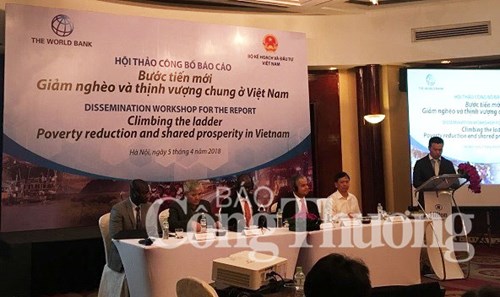According to the Report “Climbing the Ladder: Poverty Reduction and Shared Prosperity in Vietnam” released by the WB at a workshop in Hanoi on April 5, improving income from highland agriculture can help Vietnam further reduce poverty, which has fallen by almost 4 percentage points since 2014, to 9.8 percent in 2016.
    |
 |
|
At the workshop. Photo: baocongthuong.vn |
Ethnic minorities - many of them living in highland areas - account for 72 percent of Vietnam’s poor, and encouraging them to grow more profitable industrial crops may improve their earnings.
Addressing the workshop, WB Country Director for Vietnam Ousmane Dione said Vietnam has achieved tremendous results in reducing poverty and improving the quality of life for millions.
The decline in poverty among ethnic minorities is encouraging, and more focused efforts on improving their incomes can further broaden their opportunities and reduce persistent inequalities, he said.
Outlining recent trends and patterns of poverty in Vietnam, the report proposes solutions for untapped agriculture potential in highland areas where the poor are concentrated. Land use and cropping decisions, for example, contribute more to agriculture income differences between households. Low-income families in highland areas use their land to grow basic crops such as rice or maize instead of raising more profitable crops such as coffee, black pepper, or rubber.
Improving access to credit may help highland farmers make the necessary investments for higher-earning agricultural production. Strengthening earning capacity can help narrow inequalities among groups. The average per capita consumption of ethnic minorities, for example, remains less than 45 percent of the Kinh and Hoa. Moreover, the poor faces a widening gap in terms of access to upper secondary education and improved water and sanitation.
At the same time, the report recognizes that 70 percent of Vietnam’s population is now classified as economically secure, including the 13 percent who are now part of the global middle-class. These income classes are growing rapidly, rising by over 20 percentage points between 2010 and 2017.
An average of 1.5 million Vietnamese joined the global middle class each year since 2014, confirming that households continue to climb the economic ladder after escaping poverty. The rise of the consumer class changes society’s aspirations and the focus of the poverty and shared prosperity agenda shifts from combating extreme poverty to effecting broad improvements in the quality of life and supporting the further expansion of the middle class. Rapid job creation and an ongoing transition to wage employment are driving gains in poverty reduction and shared prosperity.
The report suggests several areas of strategic priorities to further reduce poverty and promote shared prosperity, including boosting labor productivity and investing in infrastructure to sustain job creation and wage growth without losing competitiveness; implementing education reforms designed to equalize opportunities and develop workforce skills; and spurring agriculture structural transformation through changing farmland use patterns, strengthening land user rights, and improving skills of the poor farmers.
Source: VNA